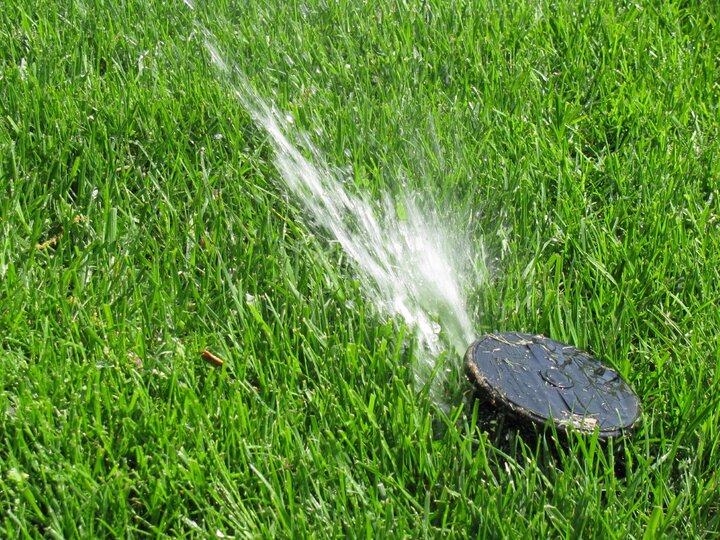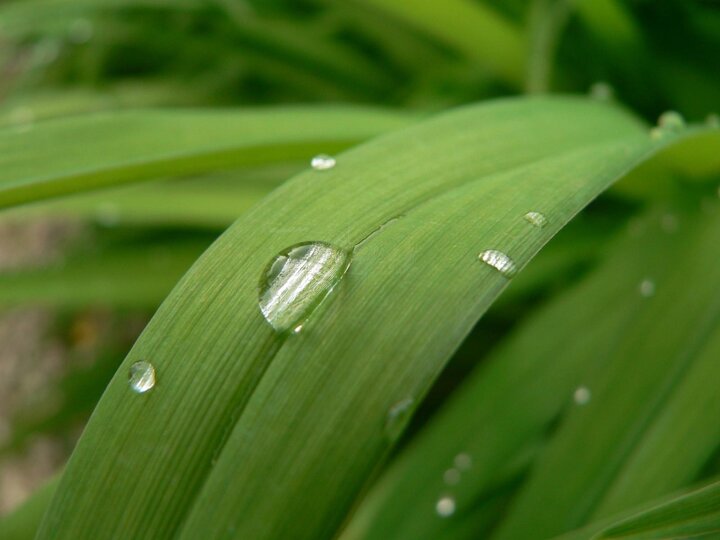Irrigation water measuring devices - tuna can and catch cup. John Fech, Nebraska Extension
It feels like August's "dog days of summer" are already here, as we and our landscapes suffer through a continuation of July's hot and dry conditions. When dry summer conditions occur, applying simple water conservation practices is beneficial for both homeowners and the environment. Instead of running up high water bills or allowing lawns to become dry and discolored, compromise by working with nature.
Watering Tips
Water plants deeply, but infrequently, when irrigation is needed. Try to keep soil moist about ½ inch deeper than the deepest living roots or, if the root depth is unknown, to 8 or 9 inches into the ground. During July and August turfgrasses and ornamental plants require 1 to 1.5 inches of water per week to remain green and actively growing. A good watering schedule for lawns on clay soil would be two, or at most three, weekly applications. Lawns and landscapes with sandy soil may require more frequent applications.
Woody plants should be watered more deeply, 12 to 18 inches, and infrequently, every 10-14 days when daytime temperatures are consistently in the 90s, to promote good root growth and health.
Avoid frequent, light applications of water, such as 10-15 minutes every day. This often results in a shallow layer of continually wet soil, which prevents oxygen movement into the soil. Plant roots need oxygen to survive, and without it they will eventually begin to die. This type of watering is particularly harmful to woody plants.
Determine Moisture Depth After Watering
An easy method to figure out how deeply your irrigation water has penetrated the soil is to stick a long-bladed screwdriver or other metal probe into the ground after irrigation. The probe should move fairly easily through moistened soil but will resist when it encounters dry soil. Remove the probe from the soil and measure the depth of soil moistened. When pulled out of the ground, the probe should be moist- not dry or soggy wet.

Watering. Monitor the output of your irrigation system by using empty coffee cans, tuna cans or other straight-sided containers to measure sprinkler output and adjust zone run times so to get the required amount. Change your irrigation system run times seasonally as plant water needs change.
Irrigation Timing. The most efficient time to water lawns & landscapes is in the early morning, from 4-10 a.m. At this time, the sun is barely out, temperatures are cooler and winds are milder than later in the day so there is less water loss to evaporation.
Mowing. Conserve moisture by mowing Kentucky bluegrass lawns to 2.5 to 3 inches and tall fescue lawns to about 3 or 4 inches. Leave grass clippings on the lawn after mowing. Clippings act as a mulch and help hold moisture in the soil.
Dormant Lawns. Consider allowing certain turfs, such as Kentucky bluegrass, to go dormant. When doing this, limit foot traffic and mowing on dormant turf to prevent damage to the grass crowns. Irrigate dormant Kentucky bluegrass with 1/2 inch of water per week, beginning after no rain has fallen for three weeks. This is the necessary amount of water needed to keep dormant Kentucky bluegrass lawns alive.
Note – tall fescue lawns do not go dormant; if entire plants are turning brown, they are dying! Additional water is needed to keep them alive, unless the browning is due to a disease problem. However, tall fescue plants have a much larger root system than Kentucky bluegrass, and can usually draw up all the water needed for plant growth unless experiencing moderate to severe drought conditions.
Mulch. Surround garden plants with a 2 to 3 inch layer of mulch to reduce evaporation and weed competition for available soil moisture.

Irrigation System Maintenance. Once a month inspect automatic sprinkler systems. Look for turf growth around the heads of the sprinklers, broken or damaged heads, clogged nozzles and other complications. Adjust sprinkler heads as plants grow or decorative items such as decks are built and start blocking the spray pattern. Make sure sprinklers don't waste water by spraying sidewalks or other impervious surfaces, and potentially wash lawn fertilizers and chemicals into storm drains.

Tweak Your Landscape Design. Assess plants that suffered this summer or required a lot of watering. Redesign the landscape so plants with similar water needs grow side-by-side. Group ornamental plants into low, moderate and high water users. This will allow you to water each according to their needs next year. Plant native and Nebraska-adapted plants that are drought-resistant to decrease the need for supplemental irrigation once plants are established.
Aerate. If your soil is clay and you had difficulty getting water to move down into the soil this summer, consider aerating in fall and/or spring. Aeration increases plant rooting due to an increase in open soil spaces and for the same reason increases water infiltration.
Improve Your Soil. Amend soil with compost, manure or leaf mold in spring or fall to improve its water-holding capacity, thus improving plant vigor and health during dry conditions.
Images
- Irrigation head needing adjustment to set output nozzle higher above grass. John Fech, Nebraska Extension
- Water drop on plant leaf. Image from Pixabay.com.
- Oscillating sprinklers are one of the least efficient ways to water a landscape, due to the amount of water lost to evaporation. Image from Pixabay.com.